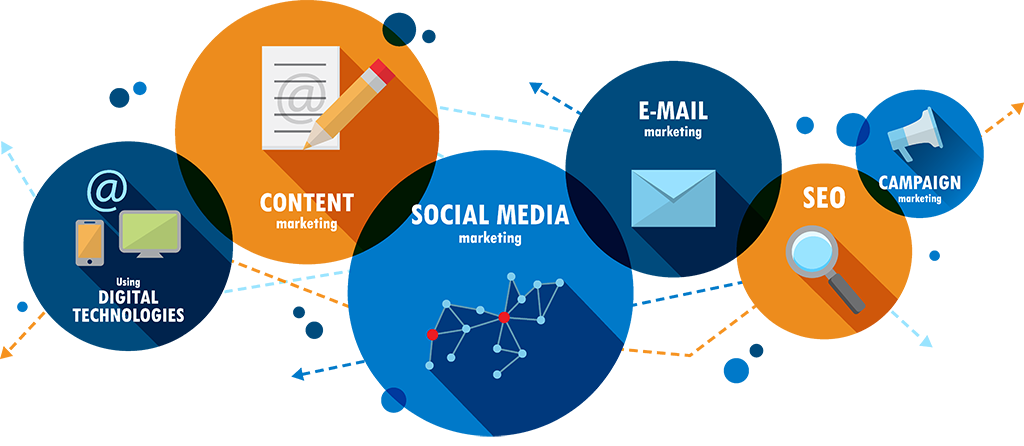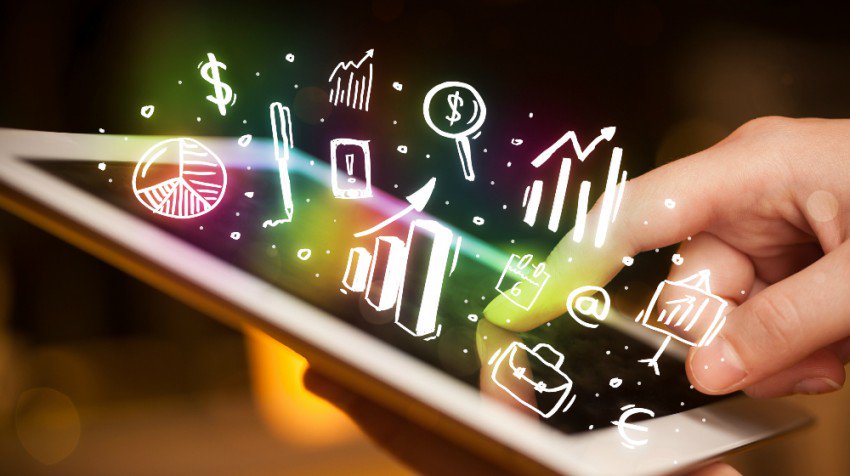
Digital marketing
January 13, 2019IF YOUR BUSINESS IS NOT ON THE INTERNET, THEN YOUR BUSINESS WILL BE OUT OF BUSINESS. Bill Gates
Digital marketing is the marketing of products or services using digital technologies, mainly on the Internet, but also including mobile phones, display advertising, and any other digital medium.
Digital marketing’s development since the 1990s and 2000s has changed the way brands and businesses use technology for marketing. As digital platforms are increasingly incorporated into marketing plans and everyday life, and as people use digital devices instead of visiting physical shops, digital marketing campaigns are becoming more prevalent and efficient.

Digital marketing methods such as search engine optimization (SEO), search engine marketing (SEM), content marketing, influencer marketing, content automation, campaign marketing, data-driven marketing, e-commerce marketing, social media marketing, social media optimization, e-mail direct marketing, display advertising, e–books, and optical disks and games are becoming more common in our advancing technology. In fact, digital marketing now extends to non-Internet channels that provide digital media, such as mobile phones (SMS and MMS), callback, and on-hold mobile ring tones. In essence, this extension to non-Internet channels helps to differentiate digital marketing from online marketing, another catch-all term for the marketing methods mentioned above, which strictly occur online.
History
The development of digital marketing is inseparable from technology development. One of the key points in the start of was in 1971, where Ray Tomlinson sent the very first email and his technology set the platform to allow people to send and receive files through different machines. However, the more recognisable period as being the start of Digital Marketing is 1990 as this was where the Archie search engine was created as an index for FTP sites. In the 1980s, the storage capacity of computer was already big enough to store huge volumes of customer information. Companies started choosing online techniques, such as database marketing, rather than limited list broker. This kind of databases allowed companies to track customers’ information more effectively, thus transforming the relationship between buyer and seller. However, the manual process was not so efficient.

In the 1990s, the term Digital Marketing was first coined,. With the debut of server/client architecture and the popularity of personal computers, the Customer Relationship Management (CRM) applications became a significant part of marketing technology. Fierce competition forced vendors to include more service into their software, for example, marketing, sales and service applications. Marketers were also able to own huge online customer data by eCRM software after the Internet was born. Companies could update the data of customer needs and obtain the priorities of their experience. This led to the first clickable banner ad being going live in 1994, which was the “You Will” campaign by AT&T and over the first four months of it going live, 44% of all people who saw it clicked on the ad.
In the 2000s, with more and more Internet users and the birth of iPhone, customers started searching products and making decisions about their needs online first, instead of consulting a salesperson, which created a new problem for the marketing department of a company. In addition, a survey in 2000 in the United Kingdom found that most retailers had not registered their own domain address. These problems made marketers find the digital ways for market development.
In 2007, the concept of marketing automation was raised to solve the problem above. Marketing automation helped companies segment customers, launch multichannel marketing campaigns and provide personalized information for customers. However, the speed of its adaptability to consumer devices was not fast enough.
Digital marketing became more sophisticated in the 2000s and the 2010s, when the proliferation of devices’ capable of accessing digital media led to sudden growth. Statistics produced in 2012 and 2013 showed that digital marketing was still growing. With the development of social media in the 2000s, such as LinkedIn, Facebook, YouTube and Twitter, consumers became highly dependent on digital electronics in daily lives. Therefore, they expected a seamless user experience across different channels for searching product’s information. The change of customer behavior improved the diversification of marketing technology.
Digital marketing is also referred to as ‘online marketing’, ‘internet marketing’ or ‘web marketing’. The term digital marketing has grown in popularity over time. In the USA online marketing is still a popular term. In Italy, digital marketing is referred to as web marketing. Worldwide digital marketing has become the most common term, especially after the year 2013.
Digital media growth was estimated at 4.5 trillion online ads served annually with digital media spend at 48% growth in 2010. An increasing portion of advertising stems from businesses employing Online Behavioural Advertising (OBA) to tailor advertising for internet users, but OBA raises concern of consumer privacy and data protection.
How Does Digital Marketing Work?

In many ways, digital marketing is no different than traditional marketing. In both, smart organizations seek to develop mutually beneficial relationships with prospects, leads, and customers.
But digital marketing has replaced most traditional marketing tactics because it’s designed to reach today’s consumers.
As an example…
Think about the last important purchase you made. Perhaps you purchased a home, hired someone to fix your roof, or changed paper suppliers at your office.
Regardless of what it was, you probably began by searching the Internet to learn more about available solutions, who provided them, and what your best options were. Your ultimate buying decision was then based on the reviews you read, the friends and family you consulted, and the solutions, features, and pricing you researched.
Most purchasing decisions begin online.

That being the case, an online presence is absolutely necessary—regardless of what you sell.
The key is to develop a digital marketing strategy that puts you in all the places your followers are already hanging out, then using a variety of digital channels to connect with them in a multitude of ways…
…Content to keep them updated with industry news, the problems they’re facing, and how you solve those problems…
…Social media to share that content and then engage with them as friends and followers…
…Search engine optimization (SEO) to optimize your content, so it will show up when someone is searching for the information you’ve written about…
…Advertising to drive paid traffic to your website, where people can see your offers…
…And email marketing to follow up with your audience to be sure they continue to get the solutions they’re looking for.
When you put all these pieces together, you’ll end up with an efficient, easy-to-operate digital marketing machine. And while it looks intimidating to build that machine from scratch, it’s as simple as learning and integrating one digital marketing tactic at a time.
Which is why we’ve put together this guide: To help you build or refine your own digital marketing plan without the false starts and missteps that come with doing it alone.
Advantages and limitations

The whole idea of digital marketing can be a very important aspect in the overall communication between the consumer and the organisation. This is due to digital marketing being able to reach vast numbers of potential consumers at one time.
Another advantage of digital marketing is that consumers are exposed to the brand and the product that is being advertised directly. To clarify the advertisement is easy to access as well it can be accessed any time any place.
However, with digital marketing there are some setbacks to this type of strategy. One major setback that is identified, is that Digital marketing is highly dependent on the internet. This can be considered as a setback because the internet may not be accessible in certain areas or consumers may have poor internet connection.
As well as digital marketing being highly dependent on the Internet is that it is subject to a lot of clutter, so it marketers may find it hard to make their advertisements stand out, as well as get consumers to start conversations about an organisations brand image or products.
As digital marketing continues to grow and develop, brands take great advantage of using technology and the Internet as a successful way to communicate with its clients and allows them to increase the reach of who they can interact with and how they go about doing so,. There are however disadvantages that are not commonly looked into due to how much a business relies on it. It is important for marketers to take into consideration both advantages and disadvantages of digital marketing when considering their marketing strategy and business goals.
An advantage of digital marketing is that the reach is so large that there are no limitations on the geographical reach it can have. This allows companies to become international and expand their customer reach to other countries other than the country it is based or originates from.
As mentioned earlier, technology and the internet allows for 24 hours a day, 7 days a week service for customers as well as enabling them to shop online at any hour of that day or night, not just when the shops are over and across the whole world. This is a huge advantage for retailers to use it and direct customers from the store to its online store. It has also opened up an opportunity for companies to only be online based rather than having an outlet or store due to the popularity and capabilities of digital marketing.
Another advantage is that digital marketing is easy to be measured allowing businesses to know the reach that their marketing is making, whether the digital marketing is working or not and the amount of activity and conversation that is involved.
With brands using the Internet space to reach their target customers; digital marketing has become a beneficial career option as well. At present, companies are more into hiring individuals familiar in implementing digital marketing strategies and this has led the stream to become a preferred choice amongst individuals inspiring institutes to come up and offer professional courses in Digital Marketing.
A disadvantage of digital advertising is the large amount of competing goods and services that are also using the same digital marketing strategies. For example, when someone searches for a specific product from a specific company online, if a similar company uses targeted advertising online then they can appear on the customer’s home page, allowing the customer to look at alternative options for a cheaper price or better quality of the same product or a quicker way of finding what they want online.

Some companies can be portrayed by customers negatively as some consumers lack trust online due to the amount of advertising that appears on websites and social media that can be considered frauds. This can affect their image and reputation and make them out to look like a dishonest brand.
Another disadvantage is that even an individual or small group of people can harm image of an established brand. For instance Dopplegnager is a term that is used to disapprove an image about a certain brand that is spread by anti-brand activists, bloggers, and opinion leaders. The word Doppelganger is a combination of two German words Doppel (double) and Ganger (walker), thus it means double walker or as in English it is said alter ego. Generally brand creates images for itself to emotionally appeal to their customers. However some would disagree with this image and make alterations to this image and present in funny or cynical way, hence distorting the brand image, hence creating a Doppelganger image, blog or content (Rindfleisch, 2016).
Two other practical limitations can be seen in the case of digital marketing. One,digital marketing is useful for specific categories of products,meaning only consumer goods can be propagated through digital channels.Industrial goods and pharmaceutical products can not be marketed through digital channels. Secondly, digital marketing disseminates only the information to the prospects most of whom do not have the purchasing authority/power. And hence the reflection of digital marketing into real sales volume is skeptical.






